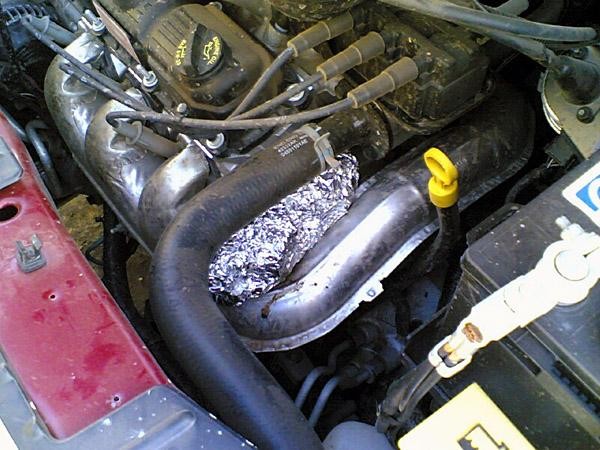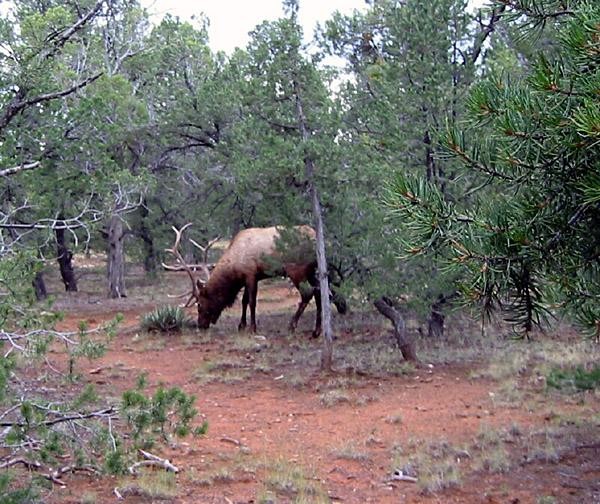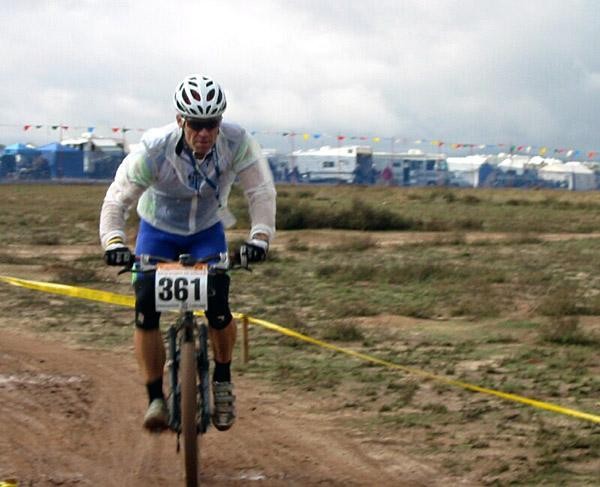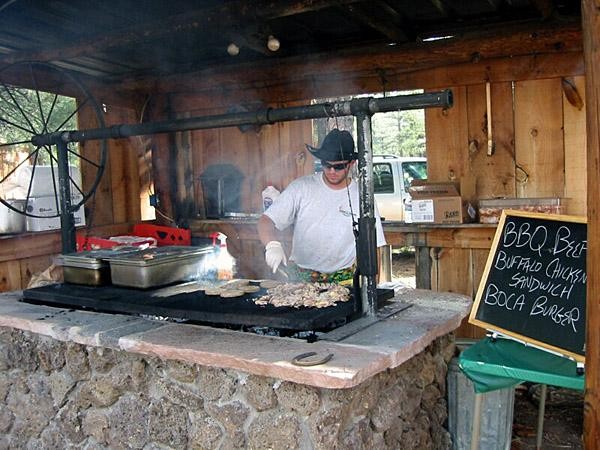The tale: Part two
The second race on the trip was the 24 Hours of Moab, so after a quick stop in Flagstaff AZ to check...




A tale of two races, December 2, 2006
The second race on the trip was the 24 Hours of Moab, so after a quick stop in Flagstaff AZ to check out the MTB situation there (t’was good, but that’s another story), and a blitz through Las Vegas to get a replacement memory chip for new laptop, I pointed the van north towards Moab.
Along the way I figured out how to cook a stew on the exhaust manifold of my van. I can’t seem to help myself…
Though team organization is not my strength (nor is organization of any kind, as my employer and friends will attest to), I was trying something new this year. I’ve raced with some very cool guys out there for the last 5 years or so. This year I invited some other friends I’d raced with and against in other races to come out and check out the race in Moab. The plan was to form two competitive teams.
Doug Long had been on a team I raced against in West Virginia for many years, and they skinned us most of the time (though we got them back one year). He’s cool, very fast, and a skilled technical rider so I figured he’s like the course in Moab. After racing with him in the 24 Hours of Landahl, MO this year I know why he can ride the technical sections so well. They may not have the Rockies in their backyard, but they ride on some very tough, rocky trails out there. Luckily, living in Missouri puts him close enough to Moab for him to consider the trip out. I had been tempting him for a few years and this year he bit.
Bruce Muhlfeld from SoCal was the other new rider. I met him standing in line in the airport in Denver a few years ago and I had seen him at a few races over the years. He checked it out last year while nursing a broken arm. This year he came out to race. There’ll be more on that a bit further down.
Eventually it turned out that there were some regulars who couldn’t make it though, so Lester the rep extraordinaire (who is no longer a rep, but running University Bikes in Boulder, CO - best of luck with it Lester) was called upon to round up some more help. And he did - Rick Garcia, a speed merchant from Gunnison, CO. He had just finished pedaling a fixed gear bike across the country in not too many days so he was definitely fit.
All of this was finalized the days before the race. I was prepared to ride solo if we ended up with 9, and had the list of shops and calls I could make if we only had 7. In the end we had enough racers for two masters teams. We figured out who would ride on which team and took off for town to sign up, getting that all done with an hour or two to spare. Even after 60 of these events, it never seems to get a lot easier. But it always works out somehow.
Cool. Time to ride.
Funny thing - it had been dumping all week in Moab too, and the rain forced the organizer to make changes in the race, but the results of the changes were very different than the revised Tour of the White Mountains.
The race course in Moab typically holds up well enough in rain. It has rained there occasionally and, a little water makes the soft sandy sections faster. But this year was different. The area was saturated from the pounding it had taken all week and sand had silted into areas that were normally packed.
We started riding laps. I was showing Doug and Bruce what I knew about lines and riding on the rocks, and figuring out what tires were likely to work. (I think they would have figured it out on their own easily enough, but it let me slow things down so I could keep up with them). Trying to predict which lines would hold up and which would crumble once there were thousands of wheels going past was challenging. It seemed like it was going to be OK if it kept drying out, but if it continued raining it would be messy in spots.
I was testing some new tubeless wheels on these laps too. 2.25” tubeless tires are fairly squirmy at 28 psi when they are mounted on a 24 mm wide rim. They are less so on a 28 mm wide rims. When the 28 mm wide rim is as light (or lighter) than the 24 mm wide rim, and everything else is equal, the outcome of the test is predictable. I raced on them. They are for bigger trail bikes with longer travel, and are not going to be billed as racing rims as far as I know (but what to I know). At the current weight spec they are fine for racing.
I also managed to crash on the day before the race in order to fulfill that aspect of my race strategy (always race nicked in some way). The bike I’d taken out for the lap was the bike I’d raced the weekend before in Pinetop to save my race bike from the grit. My tire slipped on a short rocky climb and I stopped. The pedals were dry and I couldn’t click out easily, so I fell over onto a juniper stump. My ribs took the blow. It felt exactly like getting elbowed in the ribs going up for a ball when I played soccer, so I knew what was coming. Breathing after that was painful and it was going to hurt in the race. It was a sloppy mistake; I know better but I am often a little slack at maintenance, etc. I was bummed.
The race began with a slightly comical version of the Lemans start. I can only call it comical because I wasn’t the one doing the running. Scott said he felt like he had Bozo shoes on with all the mud that stuck to the soles by the end of the run. He got through it though.
Then it started raining. There were some very sloppy early laps, but it backed off a little and things started to dry out a little. The conditions were decent on my first lap which was last in a rotation of 4.
The conditions started to come apart when it started raining again. The water didn’t soak in very fast, so all of the little gullies around the course progressed into creeks, and were on their way to becoming small rivers. That’s how it works in the desert.
From where we had pitted along the finishing straightaway it was obvious that there were a lot of riders who were having big problems with the conditions. I saw racers walking past with broken chains or some other fatal drive train maladies. There were a lot of riders coming in with very dim or dead lights because the laps were taking so much longer to complete. Some very fast guys took a long time to get back, and came in shaking their heads, chuckling (grimly) about the conditions out there.
There were some bad crashes on the rocks too. They are very slippery when they are coated with a layer of wet sand. The wet sand spreads out into a fine layer on the rock and stays there. The grains act like mini ball bearings when they are between the tire and the rock and let the tire slip when it isn’t completely straight up and rolling. The sloping sides of rocks that had 100% traction now had much less. You could lose the front wheel in a blink, and there were no soft spots to land on.
Serious injuries are tough to deal with in that area because the serious technical sections of the course are remote, difficult to get to even with a 4wd vehicle. A few too may really badly injured riders all at once could overwhelm the emergency medical folks It didn’t ever get to that point, but that it wouldn’t is only clear in the rear view mirror. The remote nature of the area also means that, unlike Pinetop, there are no alternative routes to use. With a few exceptions there was no easy way to make route changes that would ease the difficulty.
The whole thing seemed close to coming apart at the seams and Laird (the organizer) suspended the race.
OK, it’s stopped. Now how and when should it be restarted. He had done the same thing in Landahl, and the restart was simple enough. The plan in MO was to restart the race the after the storm was predicted to leave. Teams would leave at staggered starting times, based on how far behind they finished after the time the race was suspended. That is simple enough to calculate, though it gets a bit bulky when you need to calculate times for a thousand riders (at Moab) instead of a hundred (at Landahl).
Then it all became very complicated. In spite of the precedent set in MO for this situation, I heard announcements from the timing tent that there was a discussion about the best way to end this race. The conditions were so bad that some riders were out for hours after the race was called. Their slow lap times would put their teams close to the bottom of the class standings. Laird said teams could cancel that lap and start earlier the next day (with 1 lap less in the books). The calculators came out. This was an advantage for some teams. If the conditions were good in the morning you could ride a lap the following morning and get back in before you were scheduled to start if you left the last lap in. The calculators were running hard now.
Then I made a suggestion to Laird. He could stop the race timing on the lap before the one he had originally planned to do, or at any earlier time. This would have set the end of the race back to a point before the rain really trashed the course. The laps recorded at that point in the event would have been, on the average, a reflection of the race and not of the weird conditions. I didn’t think it through very long before I passed it on to him, and he didn’t take long to embrace the idea.
Teams that had good laps at the end of the race and moved up in the standings didn’t like that suggestion though, which is understandable. Neither did the folks that were there just to ride - they thought they were cheated out of the lap somehow if it wasn’t to be officially recorded. OK - there was no way to please everyone in this kind of situation.
Then things got really weird. I ended up getting some grief, though none directly to my face, because Laird mentioned in his announcement about the plan that it was my idea. Somehow people construed this to mean that I was trying to influence the results to my advantage. A quick glance at the timing records shows that the team I was racing on went backwards by a few minutes if he had followed the plan I suggested.
It all seemed so simple really. Dunno.
In the end it took weeks to sort it all out. Our team only rode one more lap the next day, as did many others. Despite the best efforts of all concerned, it was not a good way to end the race. There is not much more to say about it.
There were a few interesting side stories about the event though, probably quite a few, but only a few I know about.
The most interesting from my POV was that Bruce M. rode the fastest lap of the race on Sunday morning. He was faster than anyone in any category - pro, expert, young, whatever, he was the fastest. And he is 49 years old. How often have you seen that happen?
I’ve raced with (and against) some very fast Masters riders over the years, and there were quite a few of them in attendance this year. They were riding very well (check the lap times on the GG site). But I have never seen anything like that before. To say he was flying doesn’t do him justice - he rode faster than that. (I am thinking of inviting him back next year…).
There are some older guys that can ride pretty fast. Ned Overend comes to mind. Tinker Juarez too. But Bruce has not been a pro racer all his life. More on his background in some other installment.
The other interesting story was the party we had the evening after the race. The normal drill after one of these events is to break down the camp, chuck everything into the van, drink one beer with the team (only one - two flattens me), grab our aprons if we were close enough to the front (aprons are the trophies, fitting for a rider that also likes to cook), and head for the closest motel to sleep and generally lay around for a few days.
But with only a few laps done and plenty of sleep we were all fairly energetic so the afterparty was actually a party instead of a ghost dance. The beer guy in the massive bus had plenty of leftovers too, including some sort of Scotch Ale that was listed at 8%.
I cooked, hard, harder than I rode I suppose (though I did ride pretty hard). Here’s the last word on this.
Check Ye Olde Geezers Meat Shop on hwy 191 a little south of Moab for the game. You can find the rest at Moonflower, a small organic shop at the other end of town. The beer in Utah is 3.2% alcohol, though that seems to be creeping up to 4% in microbrew these days. It’s not a bad option when it is hot and you are a bit dehydrated. But if you want full strength stuff, you will have to bring it from out of state rest or pay the tariff at the state liquor store. You’ve been warned.
Post Deluge Full Beast Chili
1 lb Smoked Pork Neck or Shank
1 lb Ground Elk
1 lb Buffalo Steak (cubed)
1 lb Buffalo Brats
2 lbs Anasazi beans dry, sorted, rinsed and soaked
pintos or black beans will do in a pinch
2 large cans of good quality tomatoes, crushed
3 onions, diced coarsely
1 bulb garlic, cleaned and minced
1 bunch of cilantro, chopped coarsely
a few chipotle peppers (to taste - careful with these…) smashed up
or some good New Mexico roasted chilies
salt, pepper, water, etc
Use a massive Dutch oven or Stock pot over a fire or on a large camp stove. Hanging the Dutch oven over the fire like a cauldron would be a classy touch…
Preheat the vessel with a glug of good oil in it
Put the elk and buffalo steak and brown it all, stirring it enough to keep it from sticking
Season with salt and pepper
Remove the browned meat and reserve
Pour off any excess fat (this is unlikely to be much - the elk and buffalo are lean cuts)
Add the onions and brown them
Add the chipotle
Deglaze with a splash of water or stock if necessary
Put the browned meat back into the pot
Add the beans and enough stock or water to cover the whole mess by a few inches
Add the pork neck
Cover it and simmer for an hour, checking the fluid occasionally (don’t let it dry out)
Add the Brats, simmer it some more and keep checking it so that it doesn’t dry out and scorch
Adjust seasoning
It’s done when the beans are cooked through and tender, at least a couple of hours.
Stir in the cilantro and serve it up with cornbread or polenta, or without too.
Eat it, and put the fire out with beer.

Thank you for reading 5 articles this month*
Join now for unlimited access
Enjoy your first month for just $1
*Read 5 free articles per month without a subscription
After your trial you will be billed $7.99 per month, cancel anytime. Or sign up for one year for just $79
Get The Leadout Newsletter
The latest race content, interviews, features, reviews and expert buying guides, direct to your inbox!